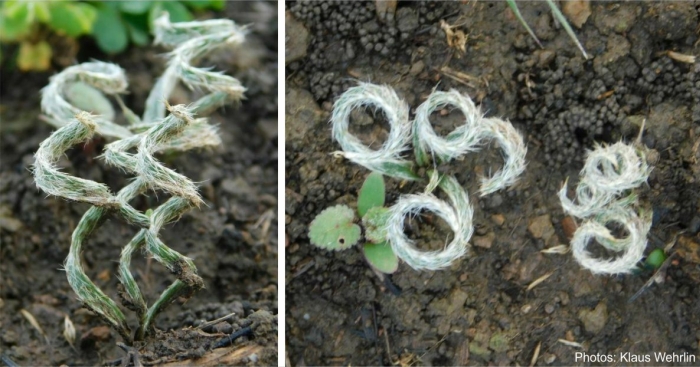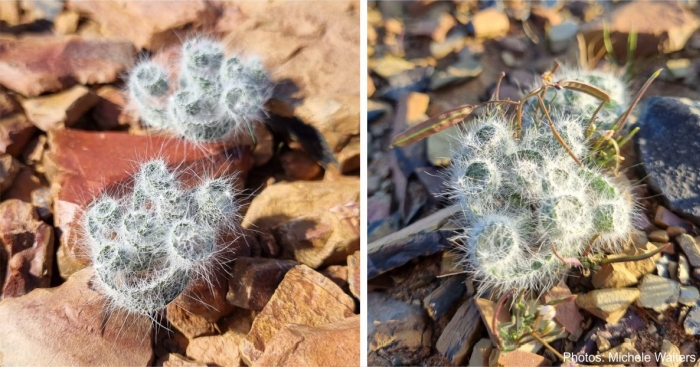Gethyllis villosa
Gethyllis villosa (Thunb.) Thunb.
Family: Amaryllidaceae
Common names: hairy kukumakranka (Eng.); kukumakranka, koekemakranka, kroekemakrank (Afr.)
Introduction
Gethyllis villosa is one of the most intriguing members of the Amaryllidaceae family in southern Africa, due to its peculiar hairy, spiral foliage, fleeting summer blooms, and fragrant autumn fruits.

Description
Description
A tiny bulbous plant of 30 to 150 mm in height, Gethyllis villosa has loosely spiralled strap-like leaves covered with white hairs with the appearance of stars. The flowers are white or pink and have a distinctively bent style, a feature of this species. After the leaves wither at the end of spring, the end of the winter growing season, G. villosa blooms (October to March in the wild). Hysteranthy, a phenomenon where plants flower without leaves being present, while the plant is inactive, is frequent in geophytes, also known as bulbous plants. The flower appears in the same location after the leaves have withered and vanished.
The little bulb is oval, with a diameter of 18 to 24 mm. More than 25 mm is formed above the crown by the tunic. The leaves are linear, 40–50–75–120 mm long, 1.5–4–5 mm wide, flat, with varied helices, twisting loosely toward the apex. The leaves are bristly, white, and heavily covered in fine, upward-facing, or downward-curving, T-shaped hairs. Each bulb produces 5–10 leaves after the flowers, i.e. at the time of flowering, the leaves are dry.

Flowers are star-shaped, white or pink, 40-90 mm in diameter, faintly fragrant, and most likely self-sterile. One flower is produced per bulb each season. The petioles have a diameter of 2.5–3.5 mm and a length of 35–80 mm. The flower has six distinct tepals, each 20-40 mm long, six stamens and six anthers, the anthers about as long as the filaments, and a style that is longer than the stamens, roughly 15 mm long. The style is straight, curved sideways and has a broad 3-lobed stigma. The perianth tube is 50–100 mm long and is covered in long, soft hairs. The segments are 4 mm wide, lanceolate, and reflexing. The stamens are one third of the length of the segments.
The fruit is a club-shaped berry that is aromatic when ripe, white to off-white to yellow, 50 mm long and 8 mm in diameter containing red seeds. The ovary expands after pollination to form the fruiting body. The berries develop gradually over a period of about 2 months and protrude above the ground when they are ripe, in autumn, the beginning of the growing season. This allows them to discharge their seeds during the wet season. Each fruit contains between 34 and 115 seeds. The berries and seeds resemble those of Gethyllis campanulata in size and shape.

Conservation Status
Status
Least concern (LC). According to the Red List of South African Plants, this species is not threatened. Its wild population is stable and can still be found in abundance in its areas of distribution.
Distribution and habitat
Distribution description
Gethyllis villosa is found in 2 provinces of South Africa, the Northern Cape and Western Cape, where it is predominantly established between Mossel Bay and the Cape Peninsula, to the western Karoo and Namaqualand. This species thrives on level terrain or south facing slopes, in sand or clay. It grows during the winter.
Derivation of name and historical aspects
History
The name Gethyllis is derived from Greek gethyon, meaning ‘bulb’. Plants in this genus are commonly called kukumakranka, koekemakranka or kroekemakrank. The species name villosa, meaning ‘shaggy’, ‘covered with long, soft, straight hairs’, refers to the hairy leaves.
Gethyllis is a genus of bulbous plants in the Amaryllis family with some 33 accepted species found in the winter-rainfall region of southern Africa. This genus is closely related to Apodolirion, which has 6 species, found in both summer- and winter-rainfall regions, ranging from the winter-rainfall Western Cape to the summer-rainfall Mpumalanga. The two genera together constitute the subtribe Gethyllidinae.

Ecology
Ecology
In the autumn, the start of the growing season, both leaves and fruits emerge at the soil's surface at the same time. The fruits fall over as they develop and, if the seeds are not eaten or removed, they will germinate as soon as they are released, to produce a thick cluster of seedlings. But the survival of the seedlings depends on timely and sufficient rainfall. Autumn is the best season for seed release in the natural habitat, to take advantage of the winter rains. The plants have leaves and grow during the winter, and in spring, when the temperatures rise and the rains end, the leaves die down and the plants become dormant.
The enormous, numerous-seeded fruits take a long time to develop and ripen, following flowering and pollination in the middle of summer, many months before. Flowering of all the plants in the population occurs at the same time (is synchronous) and each flower lasts two to three days, to accommodate the hot and dry conditions of summer. Furthermore, the ovary, which subsequently develops into the fruit, is kept cool and safe below ground level, where it ripens over several months. Although there hasn't been much research done on how Gethyllis is pollinated, the theory that moths do so doesn't appear feasible given how the style nearly entirely blocks the entrance to the long floral tube . Bees are most likely the primary pollinators because they are attracted to the abundant pollen in the large anthers. Unconfirmed claims state that rodents, tortoises, and birds consume the fruit's mushy pulp and spread its seeds. However, the occurrence of clumps of plants shows that the seeds fall adjacent to the mother plant, allowing the seedlings to stay in environments that have historically been favourable for survival.
Uncertainty surrounds the reason for the spiralled leaves of many species of Gethyllis, but the compact arrangement, and the hairy covering, typical of G. villosa, might minimize water loss.

Uses
Use
The medicinal uses of this genus range from cures for colic, digestive disturbances, teething problems, fatigue, boils, bruises and insect bites, to being used as an aphrodisiac. Well known for its analgesic and anti-inflammatory purposes.
Growing Gethyllis villosa
Grow
While it may get scorched in a hot, sunny, dry site, it prefers some direct sunlight. It is a plant that is definitely water-wise and requires little care while growing. The weather has a big impact on how the tips of the leaves curl. While warm weather tends to produce erect, straight, uncurled leaf tips, cool, dry circumstances encourage curled leaf tips. Watering should be stopped by the time the flowers start to bloom, in order to prevent rotting of the bulbs. The plants will become dormant when the soil is allowed to dry out. For effective drainage, the growth media must contain coarse river sand or gravel. It is advised to lay gravel mulch on top of the soil so that the pot looks fascinating even when the bulbs are dormant. Plants can be left outside in the winter since their foliage is consistently hardy to -7°C. Plants should be protected in greenhouses in colder climates.
Division and seeds are used for propagation. Seed germination is simple. The method used for cleaning the seed is to split the berries open, remove the seeds from the pulp and store them in tap water for 24 hours. The seeds will begin to germinate as the fruits ripen without a pre-resting time, and in rare circumstances, germination will occur inside the berry. It is ideal to cultivate seeds in a mixture of damp peat and perlite from autumn through winter (the small fleshy seeds can be sown on top of well-drained sowing medium). Germination takes place after 6 days and a germination percentage of above 80% is normally achieved.
Past research suggests that the species is extremely difficult to propagate asexually. Various vegetative propagation techniques have been tried with mixed results, although bulb cuttings, scooping and scoring were successful and division of bulblets proved to be the most successful. The species is successfully sterilized, initiated, multiplied, rooted and hardened-off using in-vitro propagation techniques. To keep the moisture from evaporating, wrap the plant and container with a plastic bag that is fastened with a rubber band. Place beneath a fluorescent lamp or under some indirect sunlight. After it has grown for a while, repot it in its normal mix. Plant in its regular potting mix after dividing it or removing offsets.
The plant is best cultivated in deep containers, but can be used in bulb section in a garden design or in sunny rock gardens, best in water-wise, winter-rainfall gardens. The bulbs rot and die if over-watered. Water moderately to sparingly in autumn, winter and spring, stop watering when the leaves start to die and keep dry in summer.
References
- Daniels, C. 2007. Are the days of the kukumakranka numbered? Gethyllis multifolia and Gethyllis villosa in the spotlight. Veld & Flora 93(1): 23–25.
- Liltved, W.R. 1992. The Kukumakrankra, past and present. Veld & Flora 78(4): 104–106.
- LLifle, Encyclopedia of Bulbs. Gethyllis villosa. http://llifle.net/Encyclopedia/BULBS/Family/Amaryllidaceae/33530/Gethyllis_villosa. Accessed on 25/07/2022.
- Manning, J. & Goldblatt, P. 2012. Plants of the Greater Cape Floristic Region 1: the Core Cape Flora. Strelitzia 29. South African National Biodiversity Institute, Pretoria.
- Snijman, D.A. & Victor, J.E. 2004. Gethyllis villosa (Thunb.) Thunb. National Assessment: Red List of South African Plants version 2020.1. Accessed on 2022/07/25.
- Snijman,D. 2004. Gethyllis L. (Amaryllidaceae). PlantZAfrica. Online. http://pza.sanbi.org/gethyllis.
Credits
Asiphe Mtsuma
Karoo Desert National Botanical Garden
October 2022
Acknowledgements: the author thanks their Supervisor, Shireen Harris, for the guidance and advice, without whom this wouldn’t be possible; and Bevan Duffett, Lennart N, Klaus Wehrlin, Ohna Wessels and Michele Walters for the amazing pictures used to illustrate this article.
Plant Attributes:
Plant Type: Bulb
SA Distribution: Northern Cape, Western Cape
Soil type: Sandy, Clay
Flowering season: Late Summer
PH: Acid
Flower colour: White, Pink
Aspect: Full Sun
Gardening skill: Challenging
Special Features:
Horticultural zones








Rate this article
Article well written and informative
Rate this plant
Is this an interesting plant?
Login to add your Comment
Back to topNot registered yet? Click here to register.